|
Home
Galleries
Biography
Contact
Newsletter
|
Victor Steel
Photography
e-Bulletin
No. 002
July 2006
Introduction:
This issue's theme: Tanzania, Africa 2006.
I visited Tanzania again this year, with a group of dedicated
photographers fulfilling a lifelong dream of visiting the famed Wild
Game Parks of East Africa. Babies were the order of the day, and as
usual we had great cat activity; lions and cheetah with cubs. Several
leopards were seen, both in Tarangire National Park and in the Serengeti
National Park. Once again, we were in the capable hands of
Unique Safaris, and with
three photographers per stretch Land Cruiser we had plenty of room.
|
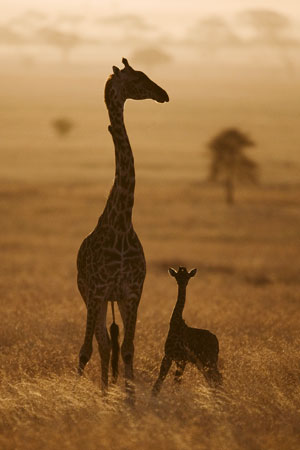 |
|
Masai Giraffe
with 3-day-old baby
In the early morning as we left
camp in the Serengeti, we happened upon these giraffes in
silhouette. By stopping the vehicle just with the sun beyond the
subject I was able to outline the baby's head with rim lighting
from the sun. The background was too bright for the lighting to
show on the mama. The baby still had some umbilical cord
remaining.
Canon 1Ds Mark II, 600mm/f4,
1/5000 @ f/4, ISO 400, EV -1 |
Itinerary:
Arusha National Park. We
visited Arusha National Park for a short day trip. This park gives an
opportunity for several animals perhaps not seen elsewhere, such as the
Colobus Monkey. Its also a great introduction to the diversity of
wildlife to be seen in the parks.
|
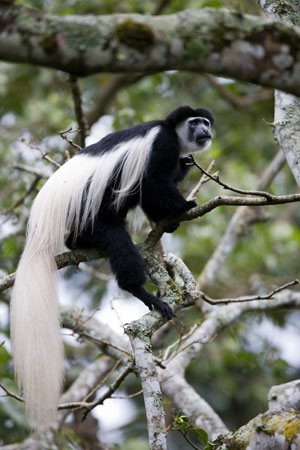 |
|
Colobus
Monkey
Arusha National Park is one
of the few places in Tanzania where Colobus monkeys can be
readily seen. These white and black monkeys are difficult to
photograph, as they are usually in the trees with bright sky
as background. Exposing for the highlights will allow the
detail in the white hair to come through, which is usually
preferable even if the dark fur goes completely black.
Canon 1Ds Mark II,
600mm/f4, 1/320 @ f/4.5, ISO 400, EV 0 |
Ngorongoro Crater. The
crater is, as always, full of excitement and non-stop action. We saw a
number of lions on the move, and had black rhino cross directly in front
of our vehicle. As there are very few black rhino left in the
world today, the Ngorongoro Crater offers a rare opportunity to see
these magnificent animals.
|
 |
|
Black
Rhinoceros
The Black Rhinoceros is
extremely endangered; so much so that Ngorongoro Crater is
one of the few places left in the world where one can have a
reasonable chance to see and photograph them.
Canon 1Ds Mark II,
600mm/f4, 1/400 @ f/8, ISO 400, EV 0 |
We arrive at the park as soon as the gates open so we
have the maximum opportunity to see diurnal and some nocturnal activity.
The lions in the Crater were on the move early in the morning, as usual,
and were checking out several herds of wildebeest and zebra. We followed
a pair of males and a pair of females as they hunted for a couple of
hours, but did not see a kill.
|
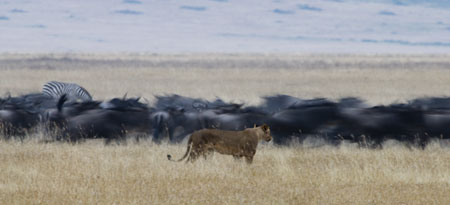 |
|
Lion
watching panicked wildebeest herd
The lions in the Ngorongoro
Crater are active early in the morning. This one of a
pair was moving by a herd of wildebeest, watching and
evaluating the possibility of a kill. The herd became
nervous and began to run wildly past her position. I used a
1/20s shutter speed to show the motion and illustrate what
was happening.
Canon 1Ds Mark II,
600mm/f4 + 2x, 1/20 @ f/22, ISO 500, EV 0 |
Tarangire National Park.
Tarangire reminds me of a prehistoric forest, with its preponderance of
Baobab trees. These trees can live over 3000 years, and are very common
here in the park. We also saw a leopard on a Baobab tree, and saw lions
and cheetahs in the park as well. We saw more elephants than ever
before, including some groups up to 60 elephants strong!
|
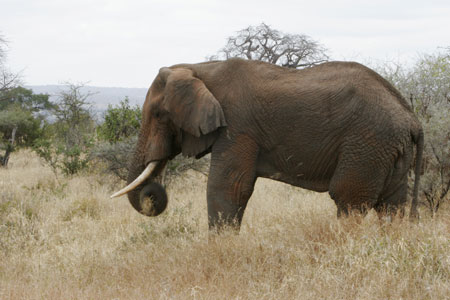 |
|
Elephant
cleaning grass
Elephants graze on the
grasses as well as the brush and trees in Tarangire National
Park. This big male was eating grass, but the dust in the
dry season can be horrendous! He would grab a mouthful, then
swirl the grass in his trunk for a few seconds to rid it of
dust and dirt before eating it. I slowed the shutter just
enough to show the blur in the trunk with the grass to
illustrate his behavior, but keeping the rest of the
elephant's body sharp.
Canon 1Ds Mark II, 600mm/f4
with 2x, 1/20 @ f/22, ISO 500, EV 0 |
Lake Manyara National Park.
This is a beautiful, small park. I sometimes refer to this park as
"Baboon Park", as I've always had great opportunities with baboons here.
The scenery here is also beautiful, with both the lake and mountains to
see.
|
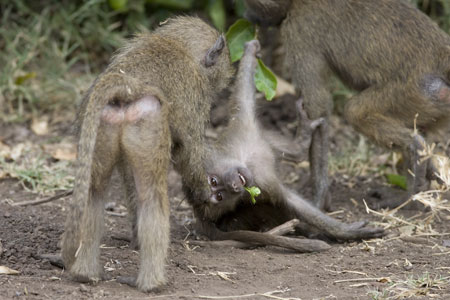 |
|
Olive
Baboons playing
These baboons were playing
near the road, jumping and fighting and running around like
a bunch of kids, for over an hour. This one in particular
seemed to be the cause of most of the activity. We watched
and photographed until the group finally moved into the
brush, encouraged by some strong words from the dominant
male.
Canon 1Ds Mark II, 600mm,
1/400 @ f/5, ISO 400, EV 0 |
|
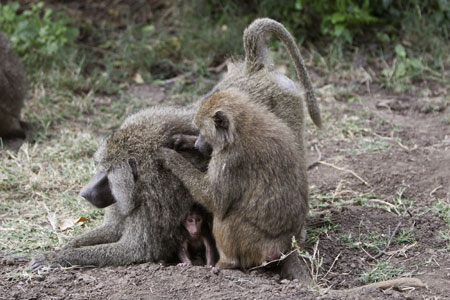 |
|
Olive
Baboons preening & peeking
Baboons are very social,
and spend a great deal of time preening each other, and
tending to their young. This pair was taking care of their
social duties, when suddenly a small baby peeked out from
under it's mama.
Canon 20D, 70-200mm @ 85mm,
1/500 @ f/2.8, ISO 400, EV 0 |
Serengeti National Park.
My favorite park in Tanzania, the Serengeti is awesome both during the
migration as well as off-migration. The various kopjes provide great
habitat for cats, and the wide-open spaces provide a great opportunity
for viewing herds of gazelle, wildebeest, zebra, and many other large
and small mammals. I always like to stay in the mobile tented camp in
the Serengeti, as the sounds surrounding the camp at night remind me
that I'm visiting the home of some very wild animals.
|
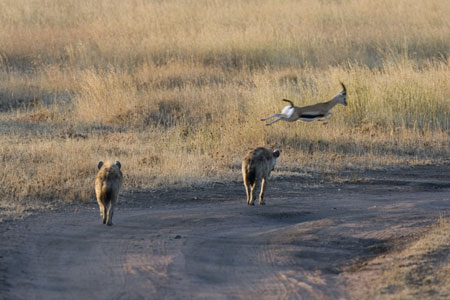 |
|
Hyenas and
Thompson's Gazelle
The hyenas were leisurely
walking down the path; they had been well-fed from the
previous night and were not interested in chasing a Tommy
today. But the Tommy was taking no chances, and he
high-tailed it once the hyenas got within "striking
distance."
Canon 1Ds Mark II, 600mm,
1/160 @ f/10, ISO 800, EV 0 |
Random Images:
Lion cubs continue to be one of my favorite
subjects in Africa. I've seen and photographed many species of mammals
in East Africa, but looking at a young lion gives me the most insight
into the power, strength and security of being at the "top of the food
chain." When I view other animals, I think of the food chain and the
circle of life, and especially the struggle to survive to adulthood.
When I look at lions, I think of winning. That is not to say, of course,
that lions do not fall victim at times, especially cubs. But being at
the top, being the dominant predator in Africa, gives a sense of
security that allows cubs to be raised and nurtured and taught
differently than any other mammal in Africa. We can learn a lot from
lions.
|
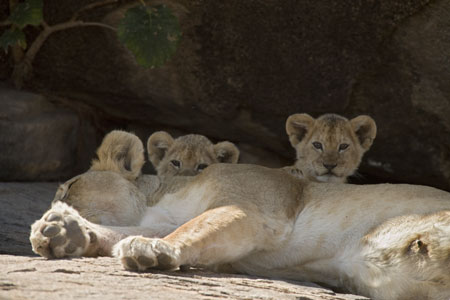 |
|
Lioness
with cubs
These lions were resting in
the shadow of a Kopjes in the mid-morning sun. The mother
was not concerned with us in the safari vehicle, but the
cubs were making sure we were keeping our distance. They
soon laid down for a nap.
Canon 1Ds Mark II, 600mm/f4
+ 2x,
1/320 @ f/8, ISO 400, EV -1/3 |
|
 |
|
Black-headed Heron
There are several herons in
Africa, and the Black-headed Heron looks similar to the Gray
Heron, but with black legs and no white on it's crown. This
heron was perched on a dead tree stump near a hippo pool in
the Serengeti National Park.
Canon 1Ds Mark II, 600mm/f4
+ 2x,
1/640 @ f/16, ISO 640, EV 0 |
|
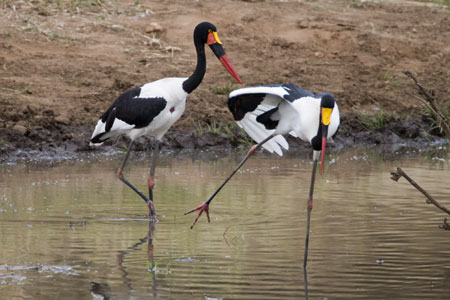 |
|
Saddle-billed Storks
This pair of saddle-billed
storks were fishing the shore of this pond, and I watched
while one stretched a wing.
Canon 1Ds Mark II, 600mm/f4
+ 2x,
1/250 @ f/8, ISO 640, EV 0 |
|
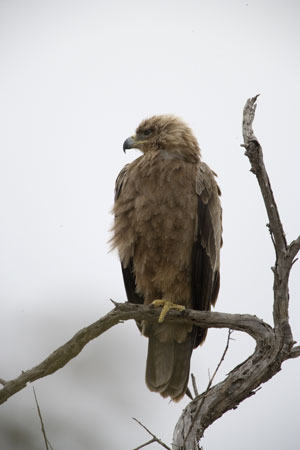 |
|
Tawny Eagle
We had stopped to
investigate a lion kill near a dead tree. As we watched the
lion feeding on the zebra, I glanced up and noticed this
Tawny Eagle perched just above on the tree.
Canon 1Ds Mark II, 600mm/f4
+ 2x,
1/80 @ f/8, ISO 500, EV +2/3 |
|
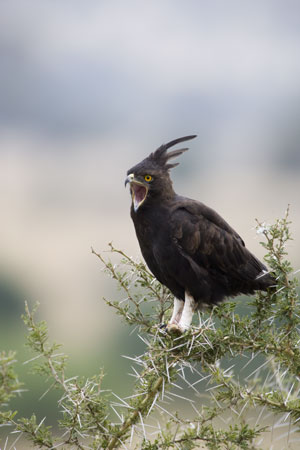 |
|
Long-Crested Eagle
The Long-Crested Eagle
calling.
Canon 1Ds Mark II, 600mm/f4
+ 2x,
1/100 @ f/8, ISO 500, EV -2/3 |
More images are
available on my web site, at
http://www.victorsteel.biz in the Galleries.
|
